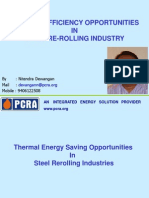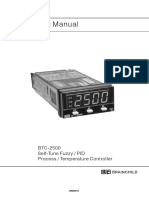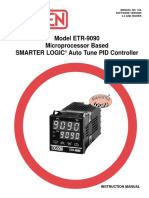Lime Kiln Control Using Simple Advanced Pid Control
Uploaded by
A Sar BanLime Kiln Control Using Simple Advanced Pid Control
Uploaded by
A Sar BanLIME KILN CONTROL USING SIMPLE ADVANCED REGULATORY CONTROL STRATEGY Serge Naud, PE & Martin Emond, PE Top
Control inc. Lvis, Qubec, Canada ABSTRACT Lime Kiln is one piece of equipment amongst the most important in pulp bleaching process. The objective of the Kiln process is to convert lime mud, by calcining, into quick lime in order to be reprocessed in the production of white liquor, passing through the lime slacker and causticizers. The great deal of heat required for this chemical reaction to take place, accounts for an important part of energy cost and consequently a crucial challenge with respect to control optimization to minimize costs in the todays worldwide economy. Lime Kiln process is strongly non-linear and therefore, represents a fundamental interest for an advanced process control solution. This latter, will ensure an overall coordination of all controllers, feed forward and major disturbances. This paper presents a simple solution based on Advanced Regulatory Control, which lies in the proper way to make use of PID controllers with multiple Feed forwards. The benefits of this type of solution are based on the use of existing built-in PID blocs available in the control system, the robustness with proper tuning, the feed forwards on major disturbances and the low cost implementation. The maintenance of this type of control strategy is the most simple due to fact that basic PID controllers are being used and require simple test to keep them at their best performance. These simple tests can be easily performed periodically by plant personnel maintenance, operation and engineering in order to validate tuning and feed forward models variation over time. LIME KILN DESCRIPTION In pulp and paper mill, the lime kiln is a bottle neck for most Kraft pulp mill. The role of the kiln is to convert lime mud into lime by the calcination process. Lime mud, CaCO3 is first dried, then heat-up and finally calcinated to convert into CaO (calcium oxide) and CO2 (carbon dioxide). The chemical equation of this reaction is: CaCO3 + heat CaO + CO2. Calcium oxide, lime, will be used as a reagent in the making of caustic for the wood cooking process. The lime quality is measured by the content of the residual CO2 in the CaO. Under-cooked Lime has a poor performance in the production of white liquor and hence fresher lime needs to be used. Overcalcinated Lime generates dust that can interfere with the heat radiation measurement. Dust needs to be captured in the stack and recycled by being added to lime mud entering the kiln. Lime kiln consists of a long steel cylinder coated inside with refractory brick. Different types of refractory can be used. The decision making will depend on the operating temperature involved. Lime kiln average size is more than 100 meters long by 3 meters diameter with a production capacity of 400 metric tons/day of calcined product. Supported on riding rings, slightly inclined and rotating at very low speed, it forces 1
the lime mud, introduced at the back-end (also called the cold side) to flow toward the front-end (also called the hot side). The average residence time is approximately 3 hours. A burner system is installed at the front-end of the kiln. High temperature flame and hot gas ensure a counter-current heat transfer toward the back-end at the Lime mud inlet. These counter flows of lime mud and hot gas ensure the calcinations process. The lime kiln process is split into three sections; the first third of the kill dry the lime mud, the second third is to heat-up the lime mud and the last third is to calcinate the lime mud.
Figure 1. Lime Kiln
Drying section The drying section dries the lime mud by removing water. Lime mud, CaOCO3 + water are heated-up and leave the first sections as CaOCO3 + steam. The drying section of the kiln is equipped with pendant chains. These chain, are heated-up by the hot gas flow, and then transfer the accumulated heat to the lime mud that enters in contact with them with the tumbling effect of the rotation. This arrangement is essential to ensure efficient heat transfer because of the low gas temperature in this section would not be sufficient to dry the lime mud. In addition, chains have roles to break any balls formation. Back-end temperature is maintained at temperature of 110 degree Celsius (230 F). Lime mud leaves the drying section at temperature of about 315 Celsius (600 F). Should the temperature get too high in the drying section then chains could be badly damaged or even destroyed. On the other hand, not enough heat in the drying section produces favourable condition for balls and rings to develop. Balls formation can block the front-end output calcined product channel. Rings formation, all around the inside of the kiln, will create hot gas flow restriction. Consequently, the pressure differential in the kiln will increase. As a final result, Induced Fan is likely exposed to saturation. Rings formation can also trap lime mud for longer period resulting in burn lime.
Figure 2. Drying section
Heating section The heating section of the kiln increases the temperature of lime mud from 315 Celsius to 815 Celsius, the calcination temperature, were the calcining reaction will take place. Lime entering this section has to be completely dried otherwise balls and even worst, rings formation is to happen, as describe earlier in the drying section. Calcining section The calcining section of the kiln maintain the lime at calcinating temperature of 815 degree Celsius long enough to complete the reaction of removing the maximum of CO2. The calcining reaction is very fast (less than few seconds). The residual CO2 expected should be 2% CO2. HEAT TRANSFER PROCESS The lime reburning process consists of a heat transfer process. The production rate is governed by the heat transfer rate. If heat transfer can be increased or heat load reduced then there will be an increase in the production rate. In the drying section, heat transfer can be increased if adequate chains configuration is maintained. In the heating section, heat transfer is maintained if no ring formation arises. In the calcining section, adequate flame shape will ensure proper heat transfer. The overall refractory brick health, coated in the kiln, also contributes to a more efficient heat transfer. Damages to the refractory bricks are principally due to chemical attack or quick rate of change in temperature. TABLE I. MAINTENANCE AND OPERATION IMPACTS Items Impacts Deteriorate with high temperature Refractory Damaged by improper flame shape Shell heat loss Highly exposed to melt on high gas temperature If not sufficient in quantity risk of Chain systems balls and rings formation and requires an increase of the flue gas temperature If undersized, limits capacity ID Fan If oversized, wastes energy Flame shape Burner Overburn lime result in more makeup lime downstream Advance regulatory Steady operation control
valve to prevent the flame from exiting front-end and causing damage to equipments and possible injuries to operators. Cold-end temperature is controlled by varying hot gas flow. Excess of O2 measurement is also available to follow up the quality of emanation in the environment. Reduction of O2 is obtained by modulating secondary or primary air. A 3% of O2 excess is considered normal operating condition for a kiln. %O2 is a key parameter to appreciate the quality of the combustion reaction. During normal operating conditions, lime mud flow variation may happen. If the flow is to increase, cold-end temperature will drop. In order to maintain cold-end temperature, hot gas flow is raised by increasing the ID fan speed. More hot gas is pulled from hot-end to cold-end causing hot-end temperature to drop. To maintain hot-end temperature, fuel to burners has to be increased. If all these actions are made at the same time, chances are that the process will suffer from unbalance temperature at both ends. Consequently, some actions at the induced fan and burners must be taken. That is to say, gradually apply small change spreaded out over a period of time required by the process dynamic to react according to the new load coming in the kiln. Controlled variables are front-end temperature, back-end temperature, kiln pressure and %O2. Manipulated variables are burners gas or oil valves and primary air; induced fan speed, secondary air.
MANUAL OPERATION If someone is to operate a kiln manually, here how he should be doing. The output temperature is maintained at a constant temperature of 815 Celsius by modulating burners fuel valve. Hot gas flow through the kiln is controlled by modulating the induced fan that also has to maintain a negative pressure in the kiln. If high-pressure to occur, a protection would close fuel 2
KILN CONTROL STRATEGY The control of a Kiln can be achieved according to several approaches. Such as Multivariable, Fuzzy Logic, Expert System or Advanced Regulatory Control Strategy. They can all accomplish a great control in coordinating the large amount of parameters. However the resources in term of: level of effort, the complexity, the time frame, the robustness, the maintenance effort and finally the cost may vary a lot from one to the other. All of these advanced package: Multivariable, Expert System, Fuzzy Logic will usually require a third party software, they will require more effort, more time to implement, the feasibility for the client to maintain his system to its best is less likely possible, all of that because of their complexity. Moreover, they are all model based, which make them very sensitive to process model changes over time, except the Fuzzy Logic which is rule based. Consequently, their robustness will be greatly affected by the model variation. On the other hand, the Advanced Regulatory Control Strategy uses built-in function of the DCS or PLC, they are simpler, less time consuming, less effort to implement, the client will be able to maintain his system. Although, Advanced Regulatory Control is model based due to the fact that it uses PID controllers their robustness can be easily managed at the time of the tuning adjustment. The optimization of basic PID controller is still the least costly approach to improve performances. So now, how can a kiln process dynamic take advantage of Advanced Regulatory Control Strategy? How it works?
THE OVERALL IDEA First of all, what are we trying to control here? In order to achieve a good lime stone quality, the mass balance and the Energy balance, both need to be in equilibrium (Figure 3). That is to say, in order to be able to increase the production rate the energy must be available in the right proportion at the right timing. Should there is any air leak or an important air temperature variation or improper air-fuel ratio or the moisture content at the inlet is increasing are all likely to happen in the real life.
tonnage. As you might have noticed, the override signal passes through a High Limit zero (Figure 5).
Figure 5. High Limit zero on override
Figure 3. Energy and Mass Balance
HOW IT WORKS? Lets start with the dry end. In order to keep a good quality of the final product, the temperature at the dry end is a key parameter which deserves a close attention. This latter manipulates the amount of necessary fuel. However the dry end temperature controller output passes through a low select signal which constrains the temperature output to a typical fuel versus production rate relationship. This relationship is built according to good operating practice and past history of data. Such that, should the temperature controller output seems to be unreasonable, then the relationship will override the temperature output (Figure 4).
This function allows a decrease of the feed set point and brings it back to original set point when conditions are favourable. This turns out to be a unilateral trim action on feed operator set point. The air stream is governed by a ratio which follows the fuel flow (Figure 6). Special attention should be carried to the cross limiting mechanism between air flow and fuel flow. This mechanism ensures that on a demand for energy, the air flow is leading and vice versa on decrease for energy the fuel flow is leading. As a result, there is always a reasonable excess of some percent of Oxygen. The analyser controller plays a very important role in this scheme with respect to energy efficiency. As a matter of fact, the output of the excess oxygen controller will continuously re-adjust the air-fuel ratio. This latter, takes into consideration the possible air infiltrations or the large temperature variations between daylight conditions versus night conditions. Too much oxygen is a waste of energy; this excess of air needs to be heated up, whereas not enough oxygen may create smoke and a flame out.
Figure 6. Air/Fuel Ratio Control Strategy
Figure 4. Dry End Temperature Control Strategy
By the same occasion, this over demand from the dry end temperature control will, in return, carry a decrease in the feed 3
To pursue with the air stream, at the wet end, the ID fan is modulated by the high select between the pressure controller output and the wet end temperature controller output. These latter are acting as constrains to each other. This means that, if the wet end temperature is on set point but the pressure is getting over set point then pressure controller output will win the election at the high select and becomes the leader action that manipulates the ID fan (Figure 7). Then again, if the pressure is on set point, but the wet end temperature is getting below set point, the temperature controller will increase the ID fan speed in spite of having too much vacuum. This introduces the next subject, the feed forward between the wet end temperature controller to the dry end temperature controller (Figure 8). In the event that, the ID fan would be saturated this would cause the wet end temperature to drop. Consequently, through the feed forward link this would call
for more fuel and by the same occasion the domino effect would result eventually in a decrease of the feed rate. This feed forward link requires not only a gain multiplier but also a dynamic compensation on both parameters time constant and dead time to synchronize the application of the feed forward in a timely fashion.
Whenever, this signal is greater than 0, then there is a potential to increase the production rate (Figure 5).
HOW TO MANAGE MULTIPLE FUEL TYPE? This control strategy can also be adapted for multiple fuel type. For instance, because you are concerned with the energy cost, you may consider tuning both Temperatures, fuel flow controllers along with the production rate fuel relationship for every single fuel type. Then, whenever fuel type will be switched, tuning will be scheduled accordingly to achieve the best performance.
Figure 8. Overall Control Strategy
Figure 7. ID Fan Control Strategy
START UP CONDITIONS? With regard to start up conditions, it should be treated as special case. Therefore, from zero production to normal operating zone should be managed by the operator. Since these conditions are very special.
TABLE II. CONTROL MATRIX MVs CVs ID Fan FD Fan Feed Rate Fuel Feed Flow H Dry End H H H H Temp. Wet End H H H H Temp. Pressure H H L Fuel Flow H H Air Flow M H H H Oxygen M H L H Excess MV = Manipulated Variable (the controller moves it); CV = Controlled Variable (the controller tries to control it) H = Highly correlated, M = Medium correlated, L = Low correlated REFERENCES 1. Rick Gustafson, Pulp And Paper Process Control 2. Terry N. Adams, Lime kiln principals and operations
Figure 8. Feed Forward with Dynamic Compensation
CAN PRODUCTION RATE BE PUSHED? Opportunity gap for feed rate increase can be evaluated looking at the signal value that goes to the High Limit zero.
You might also like
- Kiln Burning Systems: Raw Mill From Storage Feed Rate100% (1)Kiln Burning Systems: Raw Mill From Storage Feed Rate43 pages
- Lime Kiln Control Using Simple Advanced Pid Control PDFNo ratings yetLime Kiln Control Using Simple Advanced Pid Control PDF4 pages
- A Competitive and Efficient Lime Industry - Technical Report by EcofysNo ratings yetA Competitive and Efficient Lime Industry - Technical Report by Ecofys72 pages
- Supervisory Fuzzy Control of A Rotary Cement KilnNo ratings yetSupervisory Fuzzy Control of A Rotary Cement Kiln4 pages
- 2 3LimeKilnChemistryEffectsonOperationsNo ratings yet2 3LimeKilnChemistryEffectsonOperations10 pages
- Annular Shaft Kiln For Lime Burning With Kiln Gas Recirculation PDFNo ratings yetAnnular Shaft Kiln For Lime Burning With Kiln Gas Recirculation PDF8 pages
- Understanding The Process Conditions in A Parallel Flow Regenerative Kiln PDFNo ratings yetUnderstanding The Process Conditions in A Parallel Flow Regenerative Kiln PDF4 pages
- Coal Combustion in A Rotary Kiln: Application Briefs From FluentNo ratings yetCoal Combustion in A Rotary Kiln: Application Briefs From Fluent2 pages
- Low Temperature Corrosion in Boiler and Its PreventionNo ratings yetLow Temperature Corrosion in Boiler and Its Prevention5 pages
- Oxyfuel Combustion in Rotary Kiln Lime Production PDFNo ratings yetOxyfuel Combustion in Rotary Kiln Lime Production PDF12 pages
- Presentation On Fuel Oil System - LatestNo ratings yetPresentation On Fuel Oil System - Latest27 pages
- Exergy Analysis of Birla Cement Plant Satna A Case StudyNo ratings yetExergy Analysis of Birla Cement Plant Satna A Case Study9 pages
- Numerical Prediction of Cyclone Pressure Drop100% (1)Numerical Prediction of Cyclone Pressure Drop5 pages
- Lecture34 - Material and Heat Balance in ConvertingNo ratings yetLecture34 - Material and Heat Balance in Converting5 pages
- What Is The Root Cause of High Vibration On Id Fan: MaintenanceforumsNo ratings yetWhat Is The Root Cause of High Vibration On Id Fan: Maintenanceforums8 pages
- A Dynamic Mathematical Model of The Complete Grate/Kiln Iron-Ore Pellet Induration ProcessNo ratings yetA Dynamic Mathematical Model of The Complete Grate/Kiln Iron-Ore Pellet Induration Process10 pages
- Rajdhani Scientific Co Bomb Calorimeter Model RSB-5 Instruction Manual100% (1)Rajdhani Scientific Co Bomb Calorimeter Model RSB-5 Instruction Manual5 pages
- Combustion Technologies: Bengt-Johan SkrifvarsNo ratings yetCombustion Technologies: Bengt-Johan Skrifvars45 pages
- Pneumatic and Hydrautic Conveying of Both Fly Ash and Bottom AshFrom EverandPneumatic and Hydrautic Conveying of Both Fly Ash and Bottom AshNo ratings yet
- Factorial Analysis o F A Cement: Portland Cement Company of Utah, Salt Lake City, Utah 84104, USANo ratings yetFactorial Analysis o F A Cement: Portland Cement Company of Utah, Salt Lake City, Utah 84104, USA7 pages
- Examining The Fundamentals of PID ControlNo ratings yetExamining The Fundamentals of PID Control7 pages
- MEC-E5004 Fluid Power Systems: Report On Servo System 2 NameNo ratings yetMEC-E5004 Fluid Power Systems: Report On Servo System 2 Name16 pages
- Dynamical Model of A Power Plant SuperheaterNo ratings yetDynamical Model of A Power Plant Superheater11 pages
- Fuzzy Gain Scheduling of PID Controllers PDFNo ratings yetFuzzy Gain Scheduling of PID Controllers PDF7 pages
- 15Ei304L-Process Control Lab Manual: Department of Electronics and Instrumentation EngineeringNo ratings yet15Ei304L-Process Control Lab Manual: Department of Electronics and Instrumentation Engineering70 pages
- Dynamic Simulation of The Sour Water Stripping Process and Modified Structure For Effective PresNo ratings yetDynamic Simulation of The Sour Water Stripping Process and Modified Structure For Effective Pres11 pages
- Trajectory Tracking For The Quadcopter UAV Utilizing Fuzzy PID Control ApproachNo ratings yetTrajectory Tracking For The Quadcopter UAV Utilizing Fuzzy PID Control Approach6 pages
- Level Control of Tank System Using PID C PDFNo ratings yetLevel Control of Tank System Using PID C PDF3 pages
- ABB Crane - US - Application Portal (Low Voltage AC Drives)No ratings yetABB Crane - US - Application Portal (Low Voltage AC Drives)3 pages
- Conex 354 Duo Multipurpose Instrument Amplifiers and Controllers 354-2200 Und - 2205 Operation and Service ManualNo ratings yetConex 354 Duo Multipurpose Instrument Amplifiers and Controllers 354-2200 Und - 2205 Operation and Service Manual0 pages
- Digital Process Controller Series: Ordering InformationNo ratings yetDigital Process Controller Series: Ordering Information27 pages
- 5e95d3ad68ad5efbbb4928cd PIB4168 DPG100 SeriesNo ratings yet5e95d3ad68ad5efbbb4928cd PIB4168 DPG100 Series10 pages
- Kiln Burning Systems: Raw Mill From Storage Feed RateKiln Burning Systems: Raw Mill From Storage Feed Rate
- Lime Kiln Control Using Simple Advanced Pid Control PDFLime Kiln Control Using Simple Advanced Pid Control PDF
- A Competitive and Efficient Lime Industry - Technical Report by EcofysA Competitive and Efficient Lime Industry - Technical Report by Ecofys
- Annular Shaft Kiln For Lime Burning With Kiln Gas Recirculation PDFAnnular Shaft Kiln For Lime Burning With Kiln Gas Recirculation PDF
- Understanding The Process Conditions in A Parallel Flow Regenerative Kiln PDFUnderstanding The Process Conditions in A Parallel Flow Regenerative Kiln PDF
- Coal Combustion in A Rotary Kiln: Application Briefs From FluentCoal Combustion in A Rotary Kiln: Application Briefs From Fluent
- Low Temperature Corrosion in Boiler and Its PreventionLow Temperature Corrosion in Boiler and Its Prevention
- Oxyfuel Combustion in Rotary Kiln Lime Production PDFOxyfuel Combustion in Rotary Kiln Lime Production PDF
- Exergy Analysis of Birla Cement Plant Satna A Case StudyExergy Analysis of Birla Cement Plant Satna A Case Study
- Lecture34 - Material and Heat Balance in ConvertingLecture34 - Material and Heat Balance in Converting
- What Is The Root Cause of High Vibration On Id Fan: MaintenanceforumsWhat Is The Root Cause of High Vibration On Id Fan: Maintenanceforums
- A Dynamic Mathematical Model of The Complete Grate/Kiln Iron-Ore Pellet Induration ProcessA Dynamic Mathematical Model of The Complete Grate/Kiln Iron-Ore Pellet Induration Process
- Rajdhani Scientific Co Bomb Calorimeter Model RSB-5 Instruction ManualRajdhani Scientific Co Bomb Calorimeter Model RSB-5 Instruction Manual
- Pneumatic and Hydrautic Conveying of Both Fly Ash and Bottom AshFrom EverandPneumatic and Hydrautic Conveying of Both Fly Ash and Bottom Ash
- Factorial Analysis o F A Cement: Portland Cement Company of Utah, Salt Lake City, Utah 84104, USAFactorial Analysis o F A Cement: Portland Cement Company of Utah, Salt Lake City, Utah 84104, USA
- MEC-E5004 Fluid Power Systems: Report On Servo System 2 NameMEC-E5004 Fluid Power Systems: Report On Servo System 2 Name
- 15Ei304L-Process Control Lab Manual: Department of Electronics and Instrumentation Engineering15Ei304L-Process Control Lab Manual: Department of Electronics and Instrumentation Engineering
- Dynamic Simulation of The Sour Water Stripping Process and Modified Structure For Effective PresDynamic Simulation of The Sour Water Stripping Process and Modified Structure For Effective Pres
- Trajectory Tracking For The Quadcopter UAV Utilizing Fuzzy PID Control ApproachTrajectory Tracking For The Quadcopter UAV Utilizing Fuzzy PID Control Approach
- ABB Crane - US - Application Portal (Low Voltage AC Drives)ABB Crane - US - Application Portal (Low Voltage AC Drives)
- Conex 354 Duo Multipurpose Instrument Amplifiers and Controllers 354-2200 Und - 2205 Operation and Service ManualConex 354 Duo Multipurpose Instrument Amplifiers and Controllers 354-2200 Und - 2205 Operation and Service Manual
- Digital Process Controller Series: Ordering InformationDigital Process Controller Series: Ordering Information

























































































